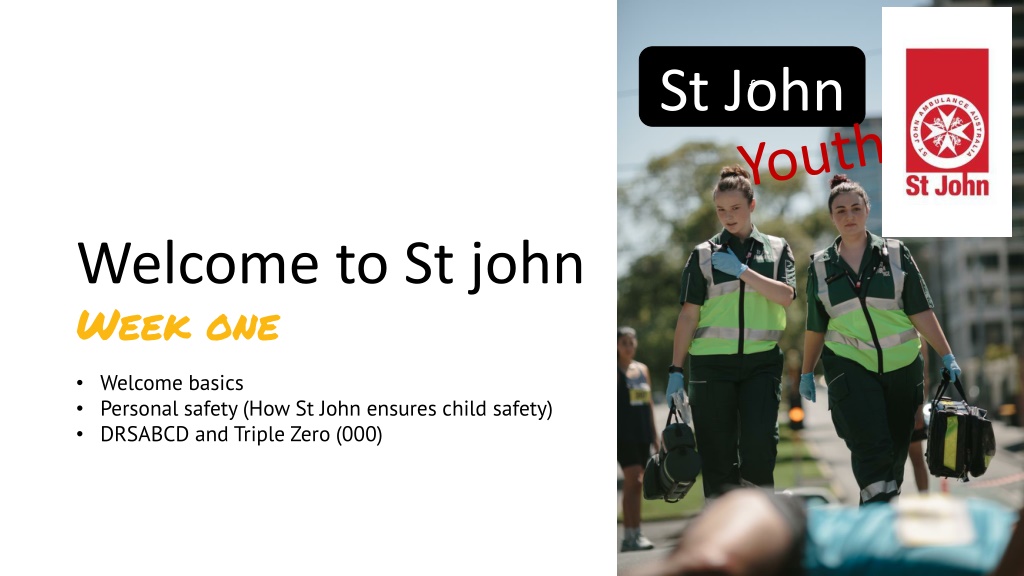St. John Child Safety: Ensuring a Secure Environment for Young Participants
St. John places a high priority on child safety within its youth program, implementing measures such as criminal history screenings, child safety training, and the presence of Child Safety Officers in every state and territory. By empowering young members and maintaining a child-safe environment, St. John promotes the well-being of all children and ensures a secure setting for participation in its activities.
Download Presentation

Please find below an Image/Link to download the presentation.
The content on the website is provided AS IS for your information and personal use only. It may not be sold, licensed, or shared on other websites without obtaining consent from the author. Download presentation by click this link. If you encounter any issues during the download, it is possible that the publisher has removed the file from their server.
E N D
Presentation Transcript
St John f Welcome to St john Week one Welcome basics Personal safety (How St John ensures child safety) DRSABCD and Triple Zero (000)
fSt Before we get started John Try these conversation starters I am a Youth Leader and my name is _______ I became involved in the St John Youth program ___________ I started when I was aged ________ or ______number of years ago. The top three things I really like about the St John Youth Program are _________ What do you prefer all your St John team members to call you? (Nickname?) Don t forget to show your new member around! Emergency exits and what to do in an emergency Toilets Out of bound areas Week one
fSt Your division John Overview of the division and structure How many members? Who is Manager and what is the structure below? Are there any other Youth Leaders/NCOs? What are members doing on a divisional night? Are you working on any badges? If so, which one? Upcoming events Week one
fSt Tell us about yourself John Is there anything you d like to share about yourself? Any siblings? Pets? Do you have any friends or family in St John? Is there anything you dislike that you would like to share? Why did you choose to come to St John? What are you hoping to experience and learn from being here? Week one
fSt What you need to know for next week Meeting times and breaks What do I do when I arrive? What to wear to divisional nights Do you need money to join or on divisional nights? What are the options if required? Do you need to ask permission to use the toilet? Contact details When and where do my parents/guardians pick me up? John Week one
fSt expectations John Simple ways to ensure that everybody is safe and has a good time Code of Conduct or Code of Behaviour Week one
fSt Personal safety John St John is committed to the safety and well being of all children and young people who participate in St John activities, programs, events or services. St John ensures child safety by doing the following: Screening of new members for criminal history Reporting obligations and processes Child safety training requirements Empowering young members Child Safety Officers in every state and territory Ensuring a child safe environment Risk management Requiring a working with children card consistent with state/territory law Week one
fSt Personal safety John Recruitment and selection All members working with, or around children must have a valid police and working with children check consistent with state/territory legislation. Child safe training All adult members are required to undertake Child Safety Awareness Training prior to commencing work with or around children and must attend the Child Safety Recertification course annually. Risk management St John in each state and territory works closely with adult members to identify and address risks to child safety in St John activities, services and programs. Week one
fSt Personal safety John Empowering young members Young members engaged in the St John Juniors and Youth program will receive annual personal safety education. The St John Personal Safety Education Framework covers a range of age and developmentally appropriate topics, including: Adult leaders Camps Keeping safe Personal space Understanding difference Bullying Cyber safety Mental health Suicide prevention Who to talk to Week one
fSt DRSABCD St John action plan John D D Danger R R Response S S Send for help A A Airway B B Breathing C C CPR D D Defibrillation
fSt Danger RSABCD John to the first aider to bystanders to the casualty Danger may include: obstacles electrical wire gas and fumes oncoming traffic uneven/unsafe surfaces Week one
fSt D response SABCD John Is the casualty conscious? Call out / ask What is your name? Squeeze the casualty's shoulders. Week one
fSt Dr Send ABCD John Call triple zero (000) and tell the operator you need the ambulance. When connected to ambulance, answer any questions they ask and provide the following information: Address of emergency Phone number you are using Your name Casualty s name & age (if known) If casualty is conscious If casualty is breathing normally Do not hang up the phone stay on the line until the operator tells you it is ok to hang up Week one
fSt DRS Airway BCD John Check the airway Clear the airway, if needed Open the airway Asphyxia is a condition that occurs when the airway is compromised. Can be due to casualty s position or foreign object in their mouth. Week one
fSt DRSA Breathing CD Look, listen and feel John Breathing normally? YES NO Recovery position Start CPR Week one
fSt DRSAB CPR D John Thirty (30) compressions TWO (2) breaths Week one
fSt DRSABC Defibrillation John Used when casualty is unconscious and not breathing normally. Used to re-establish heart rhythm. An Automated External Defibrillator (AED) is used to treat sudden cardiac arrest. Week one



























